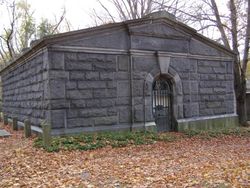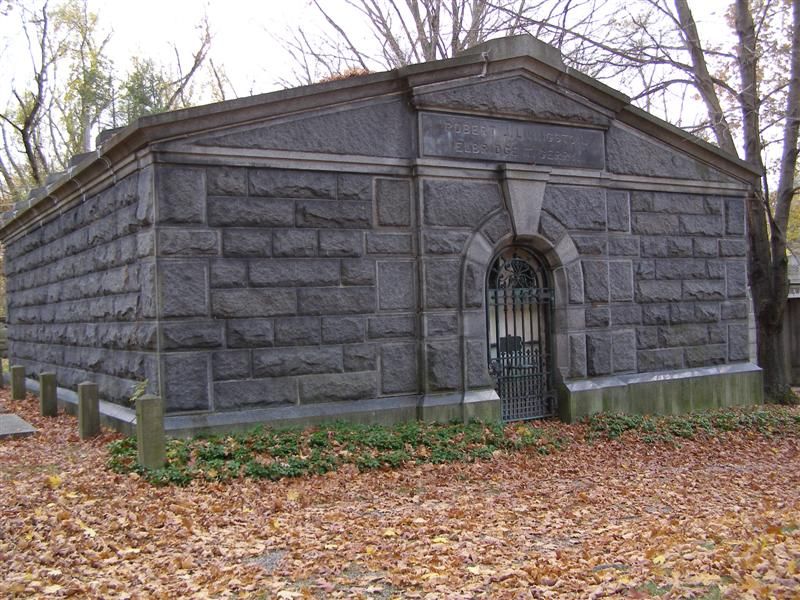She married millionaire Elbridge T Gerry, a prominent lawyer who descended from the Goelet and Gerry families.
In 1891, like most of the city's millionaires, the Gerrys planned a move northward along Central Park. They hired Richard Morris Hunt to design a lavish French Renaissance chateau at the corner of East 61st Street—one that would reconfirm the family's wealth and station.
As the plans were being developed, Hunt contracted Carlhian & Beaumetz to design and manufacture the reproduction antique furniture for the house. The French government allowed the esteemed firm to borrow pieces from museums, government-owned properties and historic palaces for use as models.
On May 15, 1892 the plans were formally announced. The New York Times reported that it would be "a combination of French, Gothic and Renaissance." The massive brick and limestone chateau would be entered on 61st street "with a covered carriage way." The newspaper spoke of "ornately-carved windows," "crocheted lintels and heavily relieved frieze," and said "two great chimneys will rise from the Sixty-first Street gable and will ascend forty feet from the nearest cornice."
Inside a grand stair hall ran through the building. Here was the marble, winding staircase and, for those too weary to climb it, an elevator. The first floor would house the dining room, Gerry's den, the library, a picture gallery and two large drawing rooms.
On the second floor were the family bedrooms. Each had a private bath and an adjoining servant's room. Along with bedrooms on the third floor were Gerry's study and an innovative addition thought up by Gerry himself.
It was an "isolating room," which was essentially a clinic, "for the care, comfort, and safety of a sufferer from contagious disease," said The Times. The newspaper added, "This unique and somewhat lugubrious apartment will be tiled and arranged so that it will be a complete hospital in itself. It is to be built simply to meet an emergency which the owner of the house hopes will never occur."
Below the dormered roof were more servants' rooms. As the $250,000 mansion began rising, the Gerrys set off for the summer at their Newport estate.
Elbridge Gerry wanted to dispel any accusations of excess, saying that his new home would "not be a palace, but simply a comfortable modern home."
Eventually the gargantuan chateau was completed and on January 11, 1897 the Gerrys opened the house to society with a large reception and dancing. The Times called it "a sort of housewarming" of the "new and handsome residence."
Mrs. Gerry's annual ball in the house was a much anticipated event; noted, according to The Times, "for their distinction and exclusiveness." Normally around 500 guests were invited and the ball rivaled Mrs. Astor's as one of the main social functions of each season.
The affairs were always lavish. When on January 12, 1914 the Gerrys gave a dinner dance for several hundred The Times mentioned that the house was "one of the largest in New York and admirably adapted to dinner dances."
For this event, tables for the dinner were arranged both in the dining room and the law library. Afterward the tables in the library were removed and dancing took place there and in the picture gallery. Because the two spaces opened into one another, they formed one long ballroom.
Mrs. Gerry's guest lists always contained only the most elite of New York Society. On this particular night she entertained the likes of Mr. and Mrs. Ogden Mills, Mr. and Mrs. W. Earl Dodge, Mr. and Mrs. August Belmont, Mr. and Mrs. Goodhue Livingston, Mr. and Mrs. Stuyvesant Fish, Mrs. William K. Vanderbilt, and Mr. and Mrs. Cornelius Vanderbilt.
The dinner dance in 1914 would be one of the last, however. Louisa M. Gerry was seen less and less at her box at the opera and the grand entertainments were few. She spent less time in the New York mansion, preferring to live at Newport.
In the Spring of 1920 she became ill and on March 27 she died in the house at No. 2 East 61st Street. Elbridge T. Gerry lived quietly on in the mansion until his own death in 1927. (Bio By Tyler Hughes).
========================================
She married millionaire Elbridge T Gerry, a prominent lawyer who descended from the Goelet and Gerry families.
In 1891, like most of the city's millionaires, the Gerrys planned a move northward along Central Park. They hired Richard Morris Hunt to design a lavish French Renaissance chateau at the corner of East 61st Street—one that would reconfirm the family's wealth and station.
As the plans were being developed, Hunt contracted Carlhian & Beaumetz to design and manufacture the reproduction antique furniture for the house. The French government allowed the esteemed firm to borrow pieces from museums, government-owned properties and historic palaces for use as models.
On May 15, 1892 the plans were formally announced. The New York Times reported that it would be "a combination of French, Gothic and Renaissance." The massive brick and limestone chateau would be entered on 61st street "with a covered carriage way." The newspaper spoke of "ornately-carved windows," "crocheted lintels and heavily relieved frieze," and said "two great chimneys will rise from the Sixty-first Street gable and will ascend forty feet from the nearest cornice."
Inside a grand stair hall ran through the building. Here was the marble, winding staircase and, for those too weary to climb it, an elevator. The first floor would house the dining room, Gerry's den, the library, a picture gallery and two large drawing rooms.
On the second floor were the family bedrooms. Each had a private bath and an adjoining servant's room. Along with bedrooms on the third floor were Gerry's study and an innovative addition thought up by Gerry himself.
It was an "isolating room," which was essentially a clinic, "for the care, comfort, and safety of a sufferer from contagious disease," said The Times. The newspaper added, "This unique and somewhat lugubrious apartment will be tiled and arranged so that it will be a complete hospital in itself. It is to be built simply to meet an emergency which the owner of the house hopes will never occur."
Below the dormered roof were more servants' rooms. As the $250,000 mansion began rising, the Gerrys set off for the summer at their Newport estate.
Elbridge Gerry wanted to dispel any accusations of excess, saying that his new home would "not be a palace, but simply a comfortable modern home."
Eventually the gargantuan chateau was completed and on January 11, 1897 the Gerrys opened the house to society with a large reception and dancing. The Times called it "a sort of housewarming" of the "new and handsome residence."
Mrs. Gerry's annual ball in the house was a much anticipated event; noted, according to The Times, "for their distinction and exclusiveness." Normally around 500 guests were invited and the ball rivaled Mrs. Astor's as one of the main social functions of each season.
The affairs were always lavish. When on January 12, 1914 the Gerrys gave a dinner dance for several hundred The Times mentioned that the house was "one of the largest in New York and admirably adapted to dinner dances."
For this event, tables for the dinner were arranged both in the dining room and the law library. Afterward the tables in the library were removed and dancing took place there and in the picture gallery. Because the two spaces opened into one another, they formed one long ballroom.
Mrs. Gerry's guest lists always contained only the most elite of New York Society. On this particular night she entertained the likes of Mr. and Mrs. Ogden Mills, Mr. and Mrs. W. Earl Dodge, Mr. and Mrs. August Belmont, Mr. and Mrs. Goodhue Livingston, Mr. and Mrs. Stuyvesant Fish, Mrs. William K. Vanderbilt, and Mr. and Mrs. Cornelius Vanderbilt.
The dinner dance in 1914 would be one of the last, however. Louisa M. Gerry was seen less and less at her box at the opera and the grand entertainments were few. She spent less time in the New York mansion, preferring to live at Newport.
In the Spring of 1920 she became ill and on March 27 she died in the house at No. 2 East 61st Street. Elbridge T. Gerry lived quietly on in the mansion until his own death in 1927. (Bio By Tyler Hughes).
========================================
Family Members
Sponsored by Ancestry
Advertisement
See more Gerry or Livingston memorials in:
- Saint James Episcopal Churchyard Gerry or Livingston
- Hyde Park Gerry or Livingston
- Dutchess County Gerry or Livingston
- New York Gerry or Livingston
- USA Gerry or Livingston
- Find a Grave Gerry or Livingston
Explore more
Sponsored by Ancestry
Advertisement










